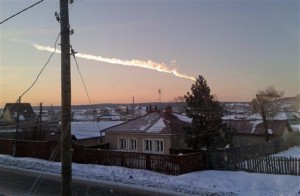Three former astronauts are sounding the alarm about the dangers our planet faces from asteroid impacts and how steps must be taken now to protect against a catastrophic asteroid strike.
The three astronauts included Ed Lu, who flew into space aboard the space shuttle, as well as a Soyuz spacecraft, to and from the International Space Station. Lu also co-founded the B612 Foundation, an organization dedicated to protecting Earth from potentially disastrous asteroid strikes. The other two astronauts include Tom Jones, a veteran of four space shuttle missions and Bill Anders, who photographed the iconic Earthrise over the desolate moonscape as a member of the 1968 Apollo 8 mission.

Infrasound arrays at the Qaanaaq, Greenland Comprehensive Nuclear Test Ban Treaty Organization’s monitoring station. (CIBTO via Wikimedia Commons)
The trio also presented a new video, produced by the B612 Foundation, which graphically illustrates just how frequently the Earth is hit by asteroids.
The data used to produce the video was provided by the Comprehensive Nuclear-Test-Ban Treaty Organization Preparatory Commission, which operates a network of monitoring stations around the world that is constantly listening for the infrasound signature of a nuclear detonation.
The video shows that in the years 2000 through 2013, there were 26 explosions on Earth due to asteroid impacts.

Trees were knocked down and burned over hundreds of square km by the Tunguska impact event. This image was taken in May 1929 during the Leonid Kulik expedition (Leonid Kulik/Wikimedia Commons)
While most of the asteroids depicted in the video exploded too high in the atmosphere to do any serious damage on the ground, the amount of energy produced by the incoming asteroids was equivalent to 1 to 600 kilotons of TNT.
The atomic bomb that exploded above the Japanese city of Hiroshima in 1945 had an energy impact of 15 kilotons.
The largest and most destructive asteroid impact event in recent history exploded over Tunguska, Siberia in 1908, and is known simply as the Tunguska impact event.
Scientists think it may have been a small asteroid or comet with an energy impact of between 5 to 15 megatons.

A meteorite contrail is seen over a village of Bolshoe Sidelnikovo 50 km of Chelyabinsk on Friday, Feb. 15, 2013. (AP)
A more recent impact involves a meteor that is thought to have been a near-Earth asteroid that exploded in an air burst over Chelyabinsk, Russia on Feb. 15, 2013.
While our atmosphere absorbed most of the object’s energy, the Chelyabinsk meteor had a pre-atmospheric impact kinetic energy total that was equivalent to approximately 500 kilotons of TNT.
The video also points out other recent asteroid impacts greater than 20 kilotons which occurred in South Sulawesi, Indonesia in 2009, in the Southern Ocean in 2004, and in the Mediterranean Sea in 2002.

Each green dot represents an asteroid in our solar system which can vary in size from very small to large. The green circle indicates Earth’s orbit. Notice the number of asteroids within Earth’s orbital path. ((c) B612 Foundation)
None of the asteroids involved in these explosive events were detected ahead of time by any space-based or Earth-based observatory.
According to Lu, less than 10,000 of the more than one million dangerous asteroids with the potential to destroy an entire major metropolitan area have been found by existing space or terrestrially-operated observatories.
“Because we don’t know where or when the next major impact will occur, the only thing preventing a catastrophe from a “city-killer” sized asteroid has been blind luck,” Lu said.
Among the efforts planned to lessen the odds of our planet someday being struck by a catastrophic asteroid, the B612 Foundation is building the first privately funded Sentinel Space Telescope Mission.
The Sentinel spacecraft is planned for launch in 2018. The infrared space telescope will scan the inner solar system, identify the current and future locations and trajectories of Earth-crossing and potentially harmful asteroids by looking for their “heat signatures”.
According to NASA’s Near Earth Object program, about 10,912 near-Earth objects have been found. Of these near-Earth objects, 862 are asteroids with a diameter of about 1 kilometer or larger and some 1,465 of these objects have been classified as Potentially Hazardous Asteroids.
Speaking at the B612 Foundation event, astronaut Tom Jones said that there could be 100,000 times more of these near-Earth objects out there that haven’t been discovered yet.
B612 Foundation officials said that the early warning system efforts such as their Sentinel mission would give those of us on Earth some time to come up with a plan to prevent deadly asteroids from striking the planet.
B612 Foundation Video Shows How Frequently Earth is Struck by Asteroids






















The hail and brimstone that Sodom&Gomorrah experienced was actually an asteroid or comet. Ancient records from middle eastern astronomers indicate this. When the world chooses to ignore God’s decrees with regard to gay sex and idolatry don’t be surprised if His protecting hand is removed that has saved us so far. In 2 Chronicles 7 vs 14 God gives us the answer for a lost world and hope for the future.
Reality NOT religion. There is no god. It`s 2014, not 614.
Dear all,
In holy Quran almighty God points to the judjement day that the world ends up one day.
and today science itself proves it up, therefore there is absolutely no doubt in the world’s deterioration.
Any irredentist country that invades or encroaches on another country’s territory, or threatens to do so by force, is distracting from the central human duty to work together to map and track asteroids larger than about 30 meters in diameter that are capable of crossing Earth’s orbit–and developing technology for deflecting asteroids that are on a collision course with Earth.
I totally agree with P, the world need to focus resources on deflecting asteroids, rather than expanding.